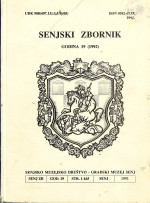PREDGORSKE STEPENICE (PEDIMENTI) GORSKOG HRPTA JUŽNOG VELEBITA
PEDIMENTS OF THE SOUTH VELEBIT
Author(s): Andrija BognarSubject(s): Physical Geopgraphy, Human Geography, Regional Geography, Historical Geography
Published by: Senjsko muzejsko društvo i Gradski muzej Senj
Keywords: pediment; range; pedimentation; slope; pediplain (pediplane);
Summary/Abstract: The transverse profile of the South Velebit, range is characteristic for its stepslike delineation. This property also substantiates a theory of a very complex evolution of the South Velebit during the orogeny development stage, marked by the alternate uplifts and relative endogenic passivness, favourable for denudation and pediplanation processes. Such a development resulted in the formation of the two clearly defined steps; one, the older and higher and the other one, younger and lower. Despite of their regional distribution, their discontinuity and different altitudes are very significant. Namely, while both of the pediments are very well developed on the seaside slope, the another Lika-slope is characterized only by the higher pediment, resulting undoubtedly from the specific morphotectonic evolution of the mountain range. Distribution, genesis and properties of the Jelar deposits are indicators of the pedimentation and pediplanation processes, during Upper Eocene until Lower Neogene. Their morphologic activity is connected with a formation of the higher and older fold-pediment. Due to the pediplanation processes, the extreeme south-east and north-west parts of the present day mountain range have been modified into one denudation level of peneplanation. Intensive tectonic, prevailingly fault-movements during neotectonic development stage, from the Mid Miocene onwards, lifted the mountain range to its present altitudes. The older pediment and a pediplane level have been disarranged. In the course of a neotectonic development stage, there was obviously one stage of tectonic passivness in Pliocene, favourable for processes of peneplanation and denudation. This stage is connected with formation of the younger pediment, whereby it probably developed during arid and cold glacial periods. Due to the recent tectonic movements in Quarternary era, this pediment has been also disarranged.
Journal: Senjski zbornik - prilozi za geografiju, etnologiju, gospodarstvo, povijest i kulturu
- Issue Year: 19/1992
- Issue No: 1
- Page Range: 1-12
- Page Count: 12
- Language: Croatian

